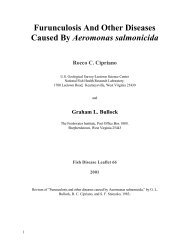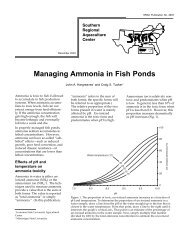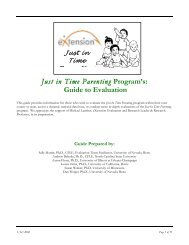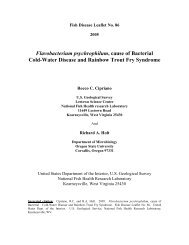A Practical Guide to Nutrition, Feeds, and ... - cop.eXtension.org
A Practical Guide to Nutrition, Feeds, and ... - cop.eXtension.org
A Practical Guide to Nutrition, Feeds, and ... - cop.eXtension.org
Create successful ePaper yourself
Turn your PDF publications into a flip-book with our unique Google optimized e-Paper software.
using this feeding strategy, but nutrient losses, especially<br />
micronutrients, are likely due <strong>to</strong> leaching of<br />
nutrients because of the extended time the pellet is in<br />
contact with the water.<br />
Food-Fish<br />
Catfish grown for food are usually s<strong>to</strong>cked as<br />
advanced fingerlings of about 5–6 inches in length<br />
(about 40–60 pounds per 1,000 fish). They are generally<br />
fed a floating feed of approximately 5/32–3/16<br />
inch in diameter containing 28–32% protein (Table 11).<br />
It has generally been recommended <strong>to</strong> start with a 32%protein<br />
feed in early spring, when temperature is<br />
relatively low <strong>and</strong> fish are feeding with less vigor. As<br />
the temperature increases <strong>and</strong> the fish are feeding vigorously,<br />
change <strong>to</strong> a 28%-protein feed <strong>and</strong> feed <strong>to</strong><br />
satiation. Starting with the 32%-protein feed appears <strong>to</strong><br />
32 A <strong>Practical</strong> <strong>Guide</strong> <strong>to</strong> <strong>Nutrition</strong>, <strong>Feeds</strong>, <strong>and</strong> Feeding of Catfish<br />
be unnecessary because there is strong evidence that<br />
the 28%-protein feed can be used throughout the<br />
growout phase without detrimental effects. Because<br />
management practices vary greatly throughout the catfish<br />
industry, the choice of which feed <strong>to</strong> use is up <strong>to</strong><br />
the individual catfish producer.<br />
On large commercial catfish farms, feed is typically<br />
blown on<strong>to</strong> the surface of the water using<br />
mechanical feeders that are either mounted on or pulled<br />
by vehicles (Figure 8). <strong>Feeds</strong> should be scattered over<br />
a large area <strong>to</strong> provide equal feeding opportunities for<br />
as many fish as possible. It is desirable <strong>to</strong> feed on all<br />
sides of the pond, but this is generally not practical on<br />
large farms where several ponds of fish must be fed in<br />
a limited period. In addition, prevailing winds dictate<br />
that feed must be distributed along the upwind levee <strong>to</strong><br />
prevent it from washing ashore.<br />
Figure 8. Catfish are being fed from a feeder drawn by a trac<strong>to</strong>r along the pond levee.






